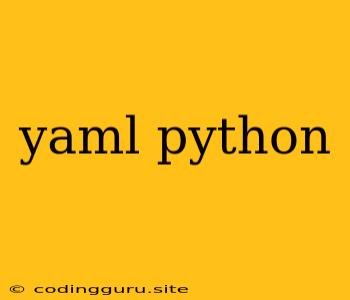YAML and Python: A Powerful Pairing for Data Management
YAML (YAML Ain't Markup Language) is a human-readable data serialization language that is often used in conjunction with Python. This pairing offers a powerful combination for managing data in a structured and organized way, making it a popular choice for developers across various fields.
Why Choose YAML with Python?
1. Simplicity and Readability: YAML's syntax is designed to be intuitive and easy to understand, even for beginners. Its use of indentation and key-value pairs makes it highly readable and maintainable, making it a perfect choice for storing configuration files, data structures, and even entire applications.
2. Python Integration: Python's robust libraries like PyYAML provide seamless integration with YAML, allowing you to easily load, parse, and manipulate YAML data. Python's dynamic typing system further complements YAML's flexible structure.
3. Data Serialization and Deserialization: YAML allows you to easily serialize complex data structures like lists, dictionaries, and nested objects into a human-readable format, and deserialize them back into Python objects. This makes it ideal for data exchange and communication between applications.
Getting Started with YAML and Python
1. Installation:
The first step is to install the PyYAML library using pip:
pip install pyyaml
2. Loading YAML Data:
Once installed, you can load a YAML file into a Python object using the yaml.safe_load() function:
import yaml
with open("config.yaml", "r") as f:
config = yaml.safe_load(f)
3. Accessing Data:
You can access the data in the YAML file through the loaded object:
print(config["database"]["host"])
print(config["app"]["name"])
4. Writing YAML Data:
To write data to a YAML file, you can use the yaml.dump() function:
import yaml
data = {"name": "John Doe", "age": 30, "city": "New York"}
with open("data.yaml", "w") as f:
yaml.dump(data, f)
Practical Applications
1. Configuration Management: YAML is widely used to store application configuration settings, providing a flexible and readable way to manage various parameters.
2. Data Serialization: YAML's human-readable format and ability to represent complex data structures make it ideal for data serialization and deserialization in applications like web services and REST APIs.
3. Scripting and Automation: YAML's simplicity and ease of use make it an excellent choice for scripting and automation tasks, where you need to manage and manipulate data in a structured way.
4. Data Analysis and Visualization: YAML can be used to store and organize data for analysis and visualization purposes, especially when working with complex data structures that require a human-readable representation.
5. Testing and Mocking: YAML's ability to represent data structures makes it suitable for creating test data and mocks for unit testing and integration testing.
Tips for Working with YAML and Python
1. Use yaml.safe_load() for security: Always use yaml.safe_load() instead of yaml.load() to prevent potential security risks from untrusted YAML data.
2. Consider using ruamel.yaml for advanced features: For more advanced features like comments preservation and automatic indentations, consider using the ruamel.yaml library.
3. Leverage YAML's data types: Utilize the various data types supported by YAML, such as lists, dictionaries, scalars, and mappings, to represent your data efficiently.
4. Maintain consistent indentation: Proper indentation is crucial for YAML's syntax and readability. Use a consistent indentation style throughout your YAML files.
5. Validate your YAML files: Use a YAML validator tool to ensure that your YAML files are syntactically correct and adhere to the YAML specification.
Conclusion
The combination of YAML and Python offers a powerful and flexible approach to data management, making it a popular choice for developers across various domains. YAML's simplicity, readability, and integration with Python's robust libraries provide a seamless experience for storing, parsing, and manipulating data in a structured and organized way. Whether you're working on configuration management, data serialization, scripting, or any other data-intensive task, YAML and Python are an ideal pairing to streamline your workflow and enhance your productivity.
